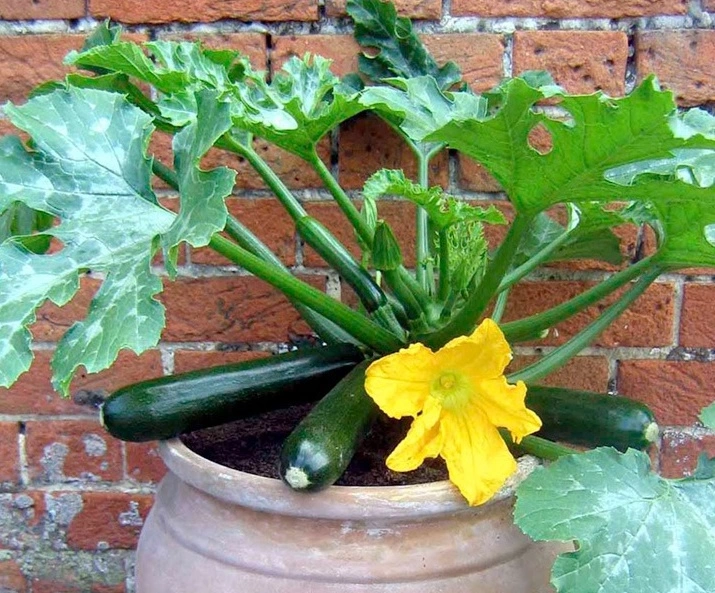Did you know that growing zucchini in pots and eating them can help you lower cholesterol, improve your vision and make you look younger? Well, that and it tastes delicious! There are more than 50 recipes with zucchini in them. While most people would pick them from the store, learning how to grow zucchini in a pot will put you on the exclusive list of farm-fresh zucchini eaters.
If you aren’t already excited about growing zucchini in pots, I hope you to have you prepping a pot and soil by the time I’m done taking you through the steps of how to grow zucchini in a pot. If you were wondering, zucchini does grow not just grow well in pots, it thrives!
Zucchini plants can take up a lot of space, but growing zucchini in pots on your patio or balcony is a welcome alternative. Read on to learn about container-grown zucchini.
When to plant Zucchini In A Pot
Timing is of the essence when learning how to grow zucchini in a pot. Plant your zucchini seeds about 2 weeks after the last frost in your area. After all the threat of frost has passed, you can either directly sow your container or transplant seedlings
How to Grow Zucchini in A Pot

Zucchini needs plenty of nutrients to grow and produce well. This means that the larger the container you can provide, the better when growing zucchini in pots. Follow the following tips. The order might change depending on your situation.
1. Choose the right pot
You don’t need a very big pot to grow zucchini.
You can begin with a pot with a minimum depth of 12 inches or 31 cm and a radius of 12 inches or 30cm. As a first step in understanding how to grow zucchini in a pot, this is crucial.
Now, you might choose to grow it in a 5-gallon bucket. That’s fine too. The process stays the same and if you follow it you can make zucchini grow in a 5-gallon bucket.
The pot you choose for growing zucchini should have a hole at the base to drain excess water. Otherwise, the soil in the pot gets soggy. And that’s how the diseases get you! It is one of the more common mistakes people make when learning how to grow zucchini in a pot.
Store-bought pots come with holes already drilled. But fear not. You can pick any used pot or plastic and drill some holes yourself. For example, a large, plastic storage container with drainage holes drilled into the bottom can work.
The pot I mentioned works for one zucchini plant. If you want to grow more than one zucchini in a container, try and get yourself a used barrel of whiskey (cut in half).
2. Pick the right soil in the beginning
The ideal soil mix for growing zucchini in pots is a lightweight, well-drained potting soil made up of peat, compost, and fine bark, as well as either perlite or vermiculite.
Standard garden soil is not the best. If you can avoid it the better for you. The reason being standard garden soil comes loaded with bugs and weed seeds which might be tough to sterilize. Also, standard garden soil quickly compacts to the point where the roots are smothered.
3. Depth and spacing
If you use direct seeding, place a few seeds 4 inches away from the container’s edge and water them in. Otherwise, you can plant two or three seeds at a depth of about an inch (2.5 cm) in the center of the pot. Separate the seeds by about 2 inches (5 cm).
Dig a hole the same depth and width as the container holding the seedling in the middle of the pot. Set the seedling in the hole after gently tugging it out of the pot. Tamp down the earth, then thoroughly water it in.
4. Choose the right variety
Miniature zucchini plants like Cue Ball, Gold Rush, and Eight Ball may be a good fit for your container garden. Until the seeds sprout in a week or two, keep an eye on your pots and make sure the soil is kept moist at all times. Lightly mist the soil and keep it damp but not waterlogged.
5. Thin the seedlings
Thin the seedlings after about two weeks if all of the seeds germinate. Pluck all of the little seedlings when the larger ones have grown to a height of 4 inches or so. One vigorous seedling will remain after the weaker ones have been removed. Protect the last remaining seedling from birds by placing a wire or plastic mesh container on top of it.
6. Place the trellis early
Prevent root injury by placing a trellis or cage near the seedling now.
If your pot is less than 20 inches wide, you should only keep one plant in it. Plants that are overcrowded do not thrive and are more susceptible to disease.
Use a product like vinyl garden tie tape or loose string to attach the vine to the building as it grows.
How to take care of a potted zucchini plant
1. Pick the right sunny spot
Zucchini plants need at least six hours of sun a day, so put the pot in a place where it will get full sun. They also need a lot of water, so if you can, put it near a water source to make things easier.
These plants don’t mind the heat either, so a south-facing wall is usually a good place for them. Just pay more attention to how wet the soil is on the hottest days and water more often if the leaves start to wilt.
If you choose a variety that grows on a vine, think about what kind of trellising system you will use. If you have a tall trellis, your pot could fall over, especially as the plant grows up it. If the pot is too small to support the weight, you will need to attach it to a wall or railing.
The space between bushes and other plants or walls should be two feet. Plants that grow on a trellis need 4 feet of space. This helps the airflow, which in turn helps keep people from getting sick.
2. Water and food
Zucchini are prolific growers. As a result, they require a substantial amount of food in order to maintain their energy levels.
Water your plants frequently, especially as the weather warms up. When the top inch or two of soil is dry, stick your finger into the soil and moisten it. In order to maintain the plant and its fruits from decaying or dying prematurely, it is important to water the plant regularly.
Potted zucchini plants also require regular fertilizing treatments.
When you water your container garden, you are removing vital nutrients from the soil and flushing them away. Adding a balanced liquid fertilizer every three to four weeks will help restore them and keep your zucchinis healthy.
3. Vine training
A trellis or support cage is necessary if you’re cultivating vining zucchinis.
Unlike pea vines, summer squash vines have tendrils that aid in their vertical growth. Although these tendrils are robust enough to support the weight of the vine, they often fail to do so as the vine begins to yield fruit.
In order to ensure that your zucchini grows vertically, you’ll need to devote most of your time and effort to training and supporting it.
Tomato cages can be used as a simple method of protecting seedlings from damage. When the plant is a few days old, carefully guide the vine back into the cage. The vine and fruit will rest on the cage, while the horizontal supports will help keep air and space open between the large leaves.
4. Protect against frost
The whole point of growing zucchini or any other plant in pots is to be able to move them around. If the weather gets too bad, you want to be able to bring the plant inside. But one good thing about a container garden is that you can bring the plants inside when it gets cold.
Because zucchini need large containers to grow, this isn’t always an option.
If it’s going to get cold enough to freeze, but you’re not ready to give up on your zucchini, you can cover the pots with a sheet to protect your plants. When it gets warmer again in the morning, take off the sheets.





[…] Zucchini […]